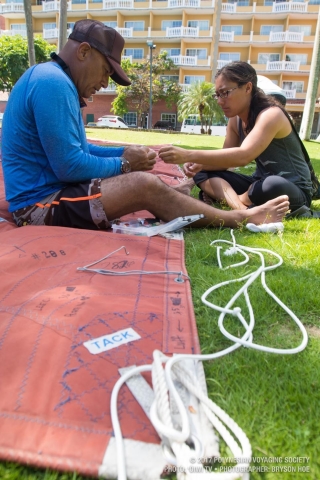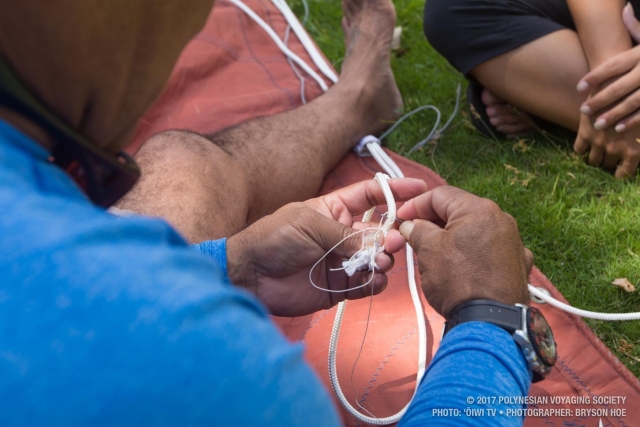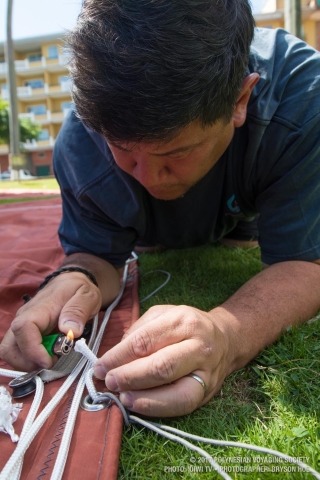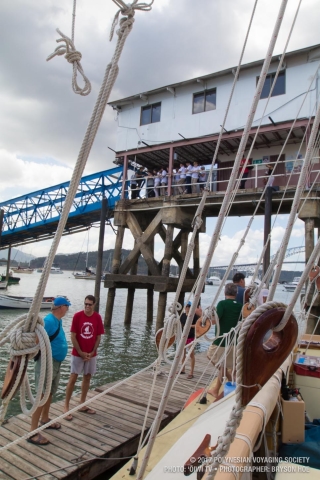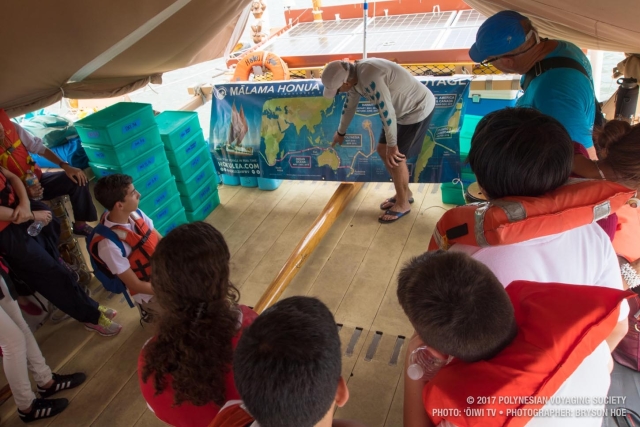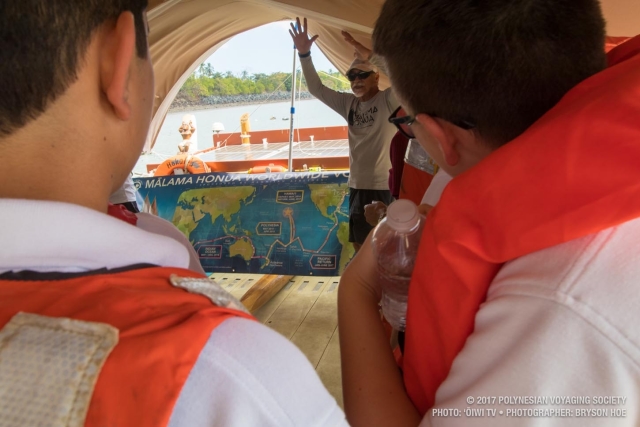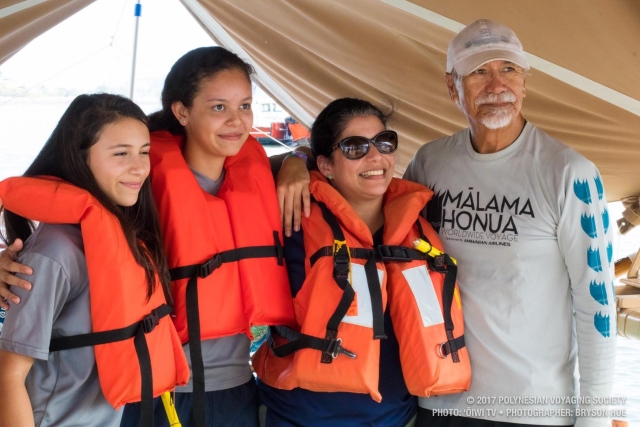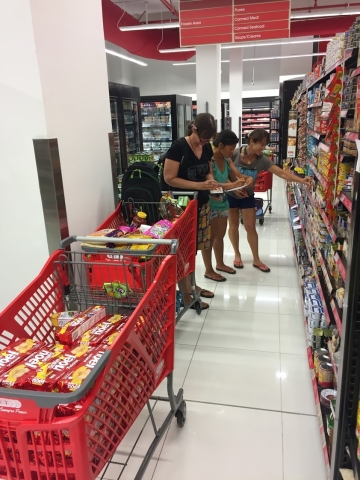
Crew Blog | Shawn Mālia Kanaʻiaupuni: Provisioning
- Posted on 17 Jan 2017
- In Newsletter, Photo Galleries, Teachers, Updates
Provisioning for a Long Sea Journey – Some of the Nuts and Bolts in a Day’s Work
Blog by Shawn Mālia Kanaʻiaupuni
Today is MLK day and it starts with a 5am crew call. Our Leg 27 crew said aloha to our brothers and sisters on Leg 26 just a couple of days ago. We mahalo them for their incredible service in carrying the messages and values of mālama honua from Miami to Panamā and for bringing our treasured Hōkūleʻa back to the Pacific Ocean for the first time in several years. They left Hōkūleʻa clean and well-organized for us, for which we are tremendously grateful.
For the transitioning crew of Leg 27, time is flying by before we depart to Galapagos. Weʻve accomplished much. The first order of business today is loading our provisions onto the canoe. Shopping earlier for provisions was a whole story in itself, involving cleaning out entire shelves of stock at the local grocery and walking out with four fully loaded shopping carts. The list included things like 37 cans of peaches, 42 cans of pears, 28 boxes of milk, endless pounds of nuts — cashews, almonds, mixed nuts — and what seemed like a million cartons of saltines. We even purchased some of that super healthy stuff that crewmembers love – yes, you guessed it, spam. And rice. Lots of rice!
Once the shopping was done, five of the crew spent a full day carefully packing these supplies into boxes with proper rations for thirteen crewmembers. The food has to last a long time, palatable to many different people on board, easy to cook in a small galley, packaged to make as little waste as possible, not too heavy (glass, liquids), and so on. The food packing list is sent ahead, built from a lot of experience gathered over the past 26 legs of this voyage around the world, including favorites from Hawaiʻi that must be hand carried for each leg, like li hing mui and other items. After packing, we labelled the boxes with blue tape numbered for each day at sea. That day was busy also for the rest of the crew, who stayed on the canoe, filling the 74 five gallon water jugs and loading them back on the canoe. They also made sure all the equipment and electricity were in good order, checking sails, and so on.
This morning, we begin early while still dark to avoid the sticky, sweaty heat and foot traffic on the pier at the Balboa Yacht Club. Itʻs a busy pier filled with local workers transporting carts of wares and various supplies in addition to sailors, visitors, and a dog who is clearly the boss. Back at our lodging, we pile 78 boxes of provisions on to carts and roll them precariously in the darkness out the driveway, bumping across the parking lot, down a small rutted incline full of potholes and onto the long wooden pier toward the canoe. Although we can see the waʻa docked off the pier, it is a long way down to sea level when the tide is low and during the day, we usually have to take a water taxi to reach her. This early in the morning, however, the tide lifts the floating dock quite a few feet. If we take advantage of the tide change, we can more efficiently load provisions in less time without using water taxis by handing them down to crew standing on the dock 8 or 9 feet below. We roll to the end of the pier and lift the boxes one by one off the side of the pier down to our tallest crew member who can almost reach the edge of the pier at this time of day. The dock is worn, tipping and swaying, bolts clanking as the crew pass heavy boxes to each other from the pier, down the dock, and haul them aboard Hōkūleʻa.
Carts unloaded, all hands jump on deck and get down into the deep hulls to load the provisions into the cargo area below each bunk. Paired in teams, we complete the job within a couple more efficient hours of work. We now have food and water packed in the canoe for most of the next two legs of the voyage.
Ready for the next activity, we quickly unload the rescue surfboard from the stern of the waʻa and carry it back with us to our lodging for training. After fueling up with a quick breakfast, we meet poolside to start rescue training with Archie Kalepa. We swim some laps to warm up and then focus seriously on learning what to do if someone falls overboard and needs to be rescued in the water. We all know that our crew is a family while at sea on Hōkūleʻa. Taking care of each other is THE number one job that we each have. So, each of us takes a turn at being rescued and being the rescuer of someone conscious and of someone unconscious. It feels awesome to have practiced this, especially knowing that an actual situation would be quite different, depending on makani and kai conditions, the speed of the canoe, where the escort boat is, the equipment functioning, and many other variables. Clearly some of our crew are experts, and at the same time, itʻs critically important that we all know what to do in a rescue situation. I make a quick mental list about who among us would be great rescue swimmers if something were to happen and feel grateful for having such an amazing crew with whom to sail on this precious canoe.
Following crew training, we prep the sails for departure on Wednesday, eat lunch, and get ready for students from the Metropolitan School of Panamá to visit the canoe at 1pm. Our day is just getting rolling!
 Todays visiting students are already part of our ʻohana. They are from a world class international baccalaureate school nearby. They have their own educational story about blending traditional and contemporary science, one inspired by our Native Hawaiian moʻolelo. For example, after reading about Hōkūleʻa and her journey, a group of these motivated students and their kumu made a plan to build a bamboo raft based on the design of the rafts originally built and used by the natives of this region. And then they accomplished exactly that. They researched, gathered materials for, and built the bamboo raft, bringing her to the same marina and putting up the sail for the first time in honor of Hōkūleʻa’s arrival to their country. What a powerful story!
Todays visiting students are already part of our ʻohana. They are from a world class international baccalaureate school nearby. They have their own educational story about blending traditional and contemporary science, one inspired by our Native Hawaiian moʻolelo. For example, after reading about Hōkūleʻa and her journey, a group of these motivated students and their kumu made a plan to build a bamboo raft based on the design of the rafts originally built and used by the natives of this region. And then they accomplished exactly that. They researched, gathered materials for, and built the bamboo raft, bringing her to the same marina and putting up the sail for the first time in honor of Hōkūleʻa’s arrival to their country. What a powerful story!
Today, 58 young, enthusiastic 7th and 8th graders join the crew on board the canoe. They chatter excitedly about the canoe, clearly stimulated about what they have learned and the experience of meeting Hōkūleʻa live and in person. Check out their awesome work for yourself: https://vimeo.com/198228781.
This educational opportunity is a beautiful way to close out the early afternoon and make way for the next set of activities. Closing for now, we say mahalo nui from Leg 27 crew to all of you, young and old, for following this voyage around the world as we do our part in service to the mālama honua mission and values while bringing Hōkūleʻa safely home. Aloha!
Hōkūle‘a Homecoming – Save the Date
Sign up for updates and be the first to know as we continue to detail homecoming festivities during the week of Hōkūleʻa’s homecoming
on June 17, 2017!

